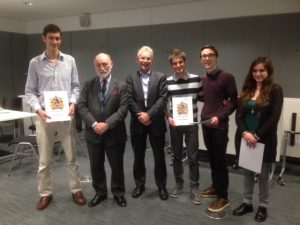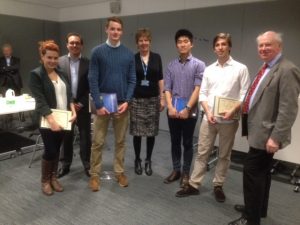Ten experienced naval architects from the Royal Institution of Naval Architects (RINA), BMT Defence Services, BMT Nigel Gee, Lloyd’s Register and the University of Southampton gathered on the 11th December to assess the concept designs in a ‘desktop review’.
Groups of third year Ship Science students took part in the Concept Design module from October until mid-December (Click here for more information) Over the semester the teams produced eight different concept designs. This year, the selected craft types were: two offshore crew boats, two customs cutters, two small fast ferries and two luxury yachts.
The RINA-BMT Design Prize was awarded to Antoine Du Baret De Lime, Ricardo Camin, Daniel Bruce and Chrysi Xanthi Lymperopoulos for their customs cutter concept design.

The Ship Science Concept Design Prize was awarded to Abigail Muscat, Max Nicholson, Jeremy Thong and Gilberto Besana.

Continue reading Concept Design Study awards presented to Ship Science 3rd year students
All posts by Steve Boyd
FSI attend the International Conference on Hydrodynamics (ICHD), Singapore, 2014.
This year, two representatives from Southampton FSI attended ICHD in October. James Hawkes presented work on linear solvers for CFD; and Puram Lakshmynarayanana presented an evaluation of hydrodynamic coefficients of a barge using CFD. The conference was hosted at Nanyang Technological University, in Singapore. The venue was close to the International High Performance Computing Centre (IHPC) to which Southampton have strong ties. A seminar was given at IHPC following the conference.

The conference covered a very broad range of hydrodynamics applications – from classical ship hydrodynamics, propeller interactions and cavitation, to coastal pollution flows and flooding simulations. There were four parallel sessions, focusing on different research areas, over the course of four days.
In the ship hydrodynamics sessions there was a strong focus on seakeeping experiments and simulations. There were also interesting presentations focused on manoeuvring, wind-assisted propulsion and sloshing effects.
The two Southampton participants both presented in the Computational Fluid Dynamics session. The session was started by a particularly interesting plenary session by Professor Frederick Stern (University of Iowa) on the recent progress in CFD – looking at simulations for naval architecture and ocean engineering. The CFD sessions were not limited to ship hydrodynamics, and included presentations on acoustic noise simulation from granular sand dune flows; numerical studies on flexible hydrofoils; hull-shape optimization algorithms; and Lagrangian particle simulations of lock-exchange flows.
The full proceedings will be available soon, at http://www.ichd2014.org .
New hydrodynamic facility taking shape

 The University of Southampton is developing a new hydrodynamic facility at the recently opened Southampton Boldrewood Innovation Campus. The aim of this facility is to provide a world class fluids facility supporting research, teaching and enterprise across the aerospace, energy, maritime and transportation sectors. This capability will complement the simulation expertise using high performance computing.
The University of Southampton is developing a new hydrodynamic facility at the recently opened Southampton Boldrewood Innovation Campus. The aim of this facility is to provide a world class fluids facility supporting research, teaching and enterprise across the aerospace, energy, maritime and transportation sectors. This capability will complement the simulation expertise using high performance computing.
Construction of the building is nearly complete and its progress since June 2014 has been captured in a time-lapse below (please click the image).

Continue reading New hydrodynamic facility taking shape
